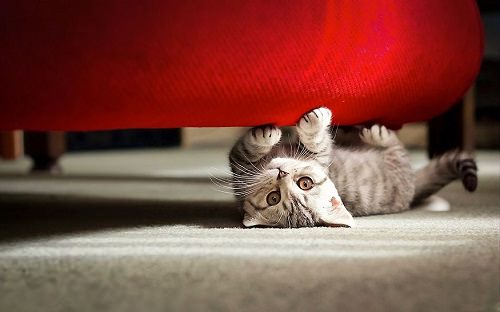Cats are mysterious and fascinating animals that have some bad habits too. Why do cats claw? This is a question that many cat owners ask. While the answer is pretty obvious, it’s important to understand a true reason and find the safest way to prevent your feline friend from destroying your furniture and the entire house. I forgive my cat many pranks because I’m bad at punishing and teaching good behaviors. So I spent a few days searching for some tricks and then testing them, and here’s what I found out:
Strong defense
All cats scratch and claw, from the smallest house cat to the largest wild cat. The use of claws is instinctual; cats use their claws both for defense and for scent marking. Cats have scent glands in their paws, as well as other places on their bodies. Cats in the wild and outdoor cats use these various scent glands to mark their territory, a way to tell other cats in the area “Hey, this is my area!” This instinct does not disappear just because a cat lives indoors and as an only cat.
Kitty’s mani
This is frequently overlooked by first time cat owners is that a cat’s claws never stop growing. The same way that your nails would continue to grow, out of control, if you stopped cutting them, a cat’s would do the same. Cat’s nails also have an outer sheath that peals away as the nail grows. Clawing helps to remove this sheath, keep the claws sharp for defending the cat’s territory and help to keep the nail from growing into the paw pad. Cats who don’t scratch and claw often wind up with over grown nails that grow into the paw pad if not trimmed, this makes walking painful and will cause an infection.
Read also – 10 Things to Consider When Looking for a Cat
4 ways to prevent your cat from ruining your furniture, walls and carpets
1. Professionally trimmed nails
Now that you know the reason for the clawing and that it’s instinctual and important to your cat’s health and well being, how to stop your kitty from shredding your new couch? Relax, there are a few ways to save your furniture. Keeping your cat’s nails trimmed is one way to cut down on clawing, if the nails are kept short they won’t do as much damage to your furniture, walls and carpet. This doesn’t, however, completely eliminate the desire to scratch.
2. Scratching posts
Instead of trying to stop a cat’s natural instinct completely, why not redirect them to an area where they are allowed to scratch and exercise their natural instinct? Scratching posts are designed specifically with cats in mind to allow them to keep their claws healthy and allow them to mark something as their own to their heart’s content. Scratching posts come in a variety of sizes and types for every home. There are small scratching posts that can sit on the floor if your cat tends to go for the carpet, scratching posts that can be hung from a door frame or wall and tall cat trees that act not only as a scratching post, but as a play area and sleeping area.
3. Correct location
Getting a cat to use a scratching post is not a difficult process. Placing the cat tree or scratching post in the area most often clawed is a good way to start. When you catch kitty clawing the back of the couch, simply move them to the scratching post, after a few times of doing this they should get the idea. Many cats are attracted to catnip and sprinkling dried catnip or using a catnip spray on the scratching post or cat tree can help to attract the cat to it. While some cats don’t have any interest in catnip at all, others seem to be able to smell it from a mile away and will come running.
4. Start early
It’s a great idea to purchase a cat tree and some smaller scratching posts before bringing a new cat home. This will allow you to start training your new friend to use them immediately and will increase your chances of the cat using the appropriate scratching areas from day one. Some cats will already know what a scratching post is and instinctually use it if it’s available to them.
Read also – 10 Reasons Why Cats Are Better Than Dogs
Remember that a cat isn’t scratching because they’re trying to misbehave or “get back at you because they’re angry”, they’re doing it because it’s an instinct and is required for the health of the nails. A cat tree or scratching post and a little bit of training will go a long way in saving your furniture and keeping your cat happy and healthy. How do you protect your home from your cat’s sharp nails?

